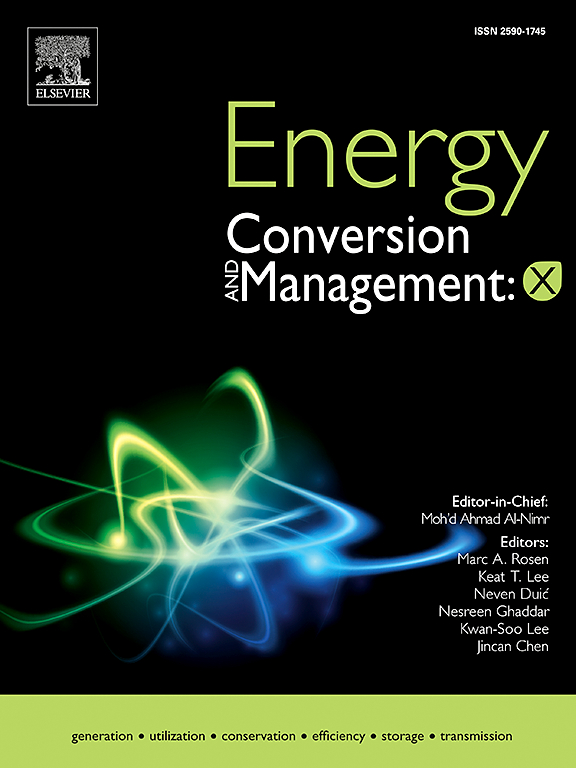A two-level real-time energy management strategy incorporating load forecasting for hydrogen fuel cell-powered ships
IF 10.9
1区 工程技术
Q1 ENERGY & FUELS
引用次数: 0
Abstract
This paper proposes a two-level real-time energy management strategy (EMS) for hydrogen fuel cell-powered ships, incorporating load forecasting, with the aim of comprehensively enhance both the energy economy and system durability. The proposed EMS is divided into two parts: ship load forecasting (SLF) and two-level real-time management (TRM). SLF employs low-pass filtering (LPF), variational mode decomposition (VMD), and an adaptive-weight lightweight gradient boosting machine (AW-LightGBM) to effectively address the uncertainty and high volatility of ship loads. This enables multi-step load forecasting at the second-level timescale, yielding a future ship loads sequence (FSLS) that is then passed on to the TRM. The TRM uses a two-level model predictive control (MPC) framework: the upper-level MPC optimizes the overall efficiency of two sets of proton exchange membrane fuel cells (PEMFCs), while the lower-level MPC minimizes the energy costs and the performance degradation costs of two sets of PEMFCs and the lithium battery (LB). Finally, the two types of energy supply devices are scheduled according to the control signals generated by the lower-level MPC. Hardware-in-the-loop (HIL) experiments indicate that, compared to other strategies, the proposed EMS significantly enhances both the energy economy and system durability of hydrogen fuel cell-powered ships during operations. Under various scenarios, the proposed EMS can achieve maximum reductions of up to 12.8% in total operating costs, 25.2% in performance degradation costs of the PEMFCs, and 17.8% in performance degradation costs of the LB, respectively.
结合负荷预测的氢燃料电池动力船舶两级实时能源管理策略
为全面提高氢燃料电池动力船舶的能源经济性和系统耐久性,提出了一种结合负荷预测的两级实时能源管理策略。该系统分为船舶负荷预测(SLF)和两级实时管理(TRM)两部分。SLF采用低通滤波(LPF)、变分模态分解(VMD)和自适应权重轻量级梯度增强机(AW-LightGBM)来有效解决船舶载荷的不确定性和高波动性。这样就可以在第二级时间尺度上进行多步负荷预测,从而产生未来船舶负荷序列(FSLS),然后将其传递给TRM。TRM采用两级模型预测控制(MPC)框架:上层MPC优化两组质子交换膜燃料电池(pemfc)的整体效率,下层MPC最小化两组质子交换膜燃料电池和锂电池(LB)的能源成本和性能下降成本。最后,根据下级MPC产生的控制信号对两种供能装置进行调度。硬件在环(HIL)实验表明,与其他策略相比,所提出的EMS在运行期间显著提高了氢燃料电池动力船舶的能源经济性和系统耐久性。在各种情况下,所提出的EMS可以最大限度地降低12.8%的总运营成本、25.2%的pemfc性能下降成本和17.8%的LB性能下降成本。
本文章由计算机程序翻译,如有差异,请以英文原文为准。
求助全文
约1分钟内获得全文
求助全文
来源期刊

Energy Conversion and Management
工程技术-力学
CiteScore
19.00
自引率
11.50%
发文量
1304
审稿时长
17 days
期刊介绍:
The journal Energy Conversion and Management provides a forum for publishing original contributions and comprehensive technical review articles of interdisciplinary and original research on all important energy topics.
The topics considered include energy generation, utilization, conversion, storage, transmission, conservation, management and sustainability. These topics typically involve various types of energy such as mechanical, thermal, nuclear, chemical, electromagnetic, magnetic and electric. These energy types cover all known energy resources, including renewable resources (e.g., solar, bio, hydro, wind, geothermal and ocean energy), fossil fuels and nuclear resources.
 求助内容:
求助内容: 应助结果提醒方式:
应助结果提醒方式:


